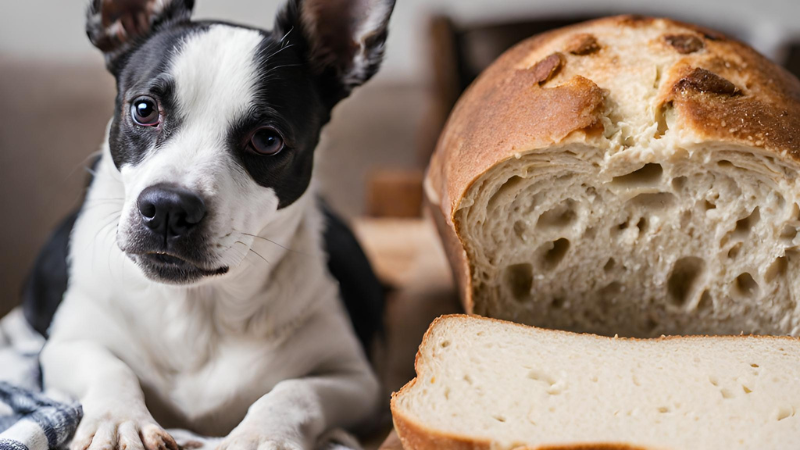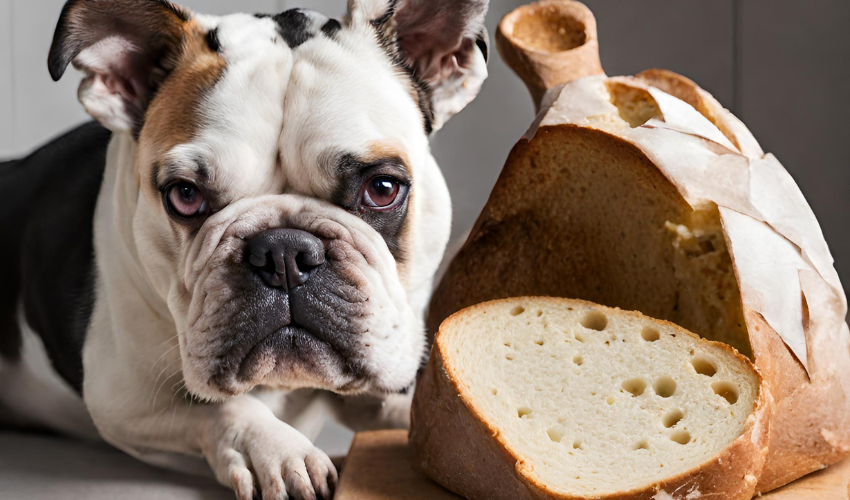Few things are as comforting as the aroma of freshly baked sourdough bread, and if you’re a dog owner, you might be tempted to share this delight with your furry friend. However, before you do, it’s crucial to understand the potential impact of feeding cooked sourdough bread to your canine companion. In this article, we’ll delve into the safety, health considerations, and best practices for including sourdough bread in your dog’s diet.
Understanding Cooked Sourdough Bread
There’s something truly special about sourdough bread with its tangy flavor and rustic charm. If you have a pet dog, you might wonder if sharing a slice of this tasty treat is okay. Let’s dive into what sourdough bread is all about and whether it’s a good fit for our four-legged friends. We’ll explore not just the ingredients that go into making sourdough but also how the bread’s preparation could affect your pup.
What Is Sourdough Bread?
Sourdough bread is more than just a delicious bakery staple—it’s a food with a story. Made from the simplest ingredients like flour, water, and salt, what sets sourdough apart is its unique leavening agent. Instead of using store-bought yeast, sourdough relies on a starter culture, which is a fermented mix of flour and water that captures wild yeast and friendly bacteria from the environment.
The fermentation not only causes the bread to rise but also gives sourdough its signature tangy flavor. This process can take longer than bread made with commercial yeast, leading to a complex taste and a texture that’s chewy on the inside with a crisp crust. While it’s a treat for our taste buds, when it comes to our four-legged pals, there are a few more things to consider.
The Cooking Process and Its Effects on Dogs
When we bake sourdough, we’re transforming basic ingredients into a crispy, golden loaf through a heat-induced chemical reaction. But what does this mean for our four-legged friends? Dogs’ digestive systems are not designed to handle all the same foods that humans can, and the cooking process for sourdough doesn’t necessarily make it dog-friendly.
During baking, fermentation causes the dough to rise, but it’s not enough to eliminate all the substances that may be tough on a dog’s stomach. Components like lactobacillus, which gives the sourdough its unique tang, may upset your pet’s gut. Plus, the crispy crust may be harder for dogs to digest compared to softer breads. So, while the aroma might make tails wag, the bread itself might lead to tummy trouble for some pups.
Can Dogs Consume Cooked Sourdough Bread Safely?
As a pet parent, you’re probably always on the lookout for snacks to add variety to your pup’s diet. But safety is your top priority, right? When it comes to sharing human foods like the much-loved homemade sourdough, it’s essential to unpack whether it’s a treat or trouble for your tail-wagging companion. So let’s chew over the facts about whether this artisanal bread is a good idea for your dog’s snack time.

Digestibility and Nutritional Value
When it comes to sharing human food with your pooch, you’ve got to be careful – and that includes the crusty loaf you just pulled out of the oven. Let’s break down the nitty-gritty on how your dog might handle this carb. Sourdough, like most bread, is packed with carbohydrates. For dogs, this isn’t exactly top-of-the-menu material; they need proteins and fats more than they need a bunch of carbs.
However, it’s not just about what nutrients are in the bread. Digestion plays a huge part. While most dogs can handle a bit of bread without trouble, sourdough’s unique properties can be a curveball. The fermentation process that gives sourdough its tangy taste can sometimes create a level of lactic acid that’s a bit of a challenge for some doggy stomachs to process. So, you’ve got to watch out for any signs of an upset tummy if your pup snags a slice.
Potential Health Risks
When thinking about sharing a slice of that warm, tangy sourdough with your pooch, it’s not just about whether they’ll enjoy the taste—it’s about their health too. Despite being cooked, sourdough can still be a risky treat for dogs. Sourdough contains lactic acid bacteria, which is beneficial to us humans, indeed, but it’s a different story for our four-legged pals.
Dogs gobbling down sourdough might face unpleasant problems like stomach aches, which are no fun for them or for you. Even serious complications like alcohol toxicosis can occur if they munch on dough that’s still fermenting, because as it ferments, it produces alcohol. And let’s not overlook the potential for allergic reactions or gluten intolerance—it’s rare, but it happens. Love means keeping your dog safe, not sharing all your snacks!
Alternatives and Precautions
We all want to see our dogs wagging their tails in pure joy, especially when they chomp on their favorite treats. Yet, it’s key to consider healthier options that align with their dietary needs. Along with understanding what’s safe, learning about suitable snack alternatives and practical tips for introducing new bites into their meals is essential for your dog’s well-being. Let’s dive into some reliable treat choices and precautionary steps to ensure our dogs are both happy and healthy.
Healthy Treats for Dogs
We all love to spoil our pups with treats, and seeing their tails wag in excitement is priceless! However, when picking out snacks, it’s essential to go for options that contribute to their health. Fruits and vegetables like carrots, apples (without the seeds!), and blueberries make fantastic treats because they are full of nutrients and have that crunch dogs usually love.
On the other hand, plain, cooked meats such as chicken or turkey are also super choices. Just be sure they’re free from any spices or sauces. Remember, treats shouldn’t make up more than 10% of your dog’s diet, so keep these goodies as a special reward rather than a staple.
Tips for Introducing New Foods
When it comes to adding variety to your dog’s diet, it’s all about starting off slow and paying close attention to their response. Begin by offering your pup a small piece of the new food, such as a tiny nibble of cooked sourdough if that’s what you’re considering. This small introduction lets you observe how they react, both taste-wise and physically.
Make sure to follow the 24-hour rule; limit the new food to a single treat and watch for any signs of upset stomach or allergies over the course of a day. It’s crucial to remember that every dog is unique, and what works for one might not work for another. If you notice any changes in their behavior, bathroom habits, or overall health, it’s best to consult with your vet. Remember, patience is key when it comes to dietary changes—take it one step at a time for a happy and healthy pooch.
The Role of Moderation
Moderation truly is the key when we talk about treating our four-legged pals. Just like us, dogs can have a little bit of everything in their diet, but it’s crucial to know when enough is enough. Keeping an eye on the amount and frequency of treats, such as baked goodies, will help ensure your dog maintains a healthy weight and doesn’t miss out on the essential nutrients their regular food provides. Let’s dive into how portion control and a balanced diet play a pivotal role in your dog’s overall health.
Portion Control for Dogs
Have you ever wondered about the right amount of treats to give your pup? Just like for us, too much of a good thing can be bad for dogs. Portion control is key when considering feeding your dog anything outside of their regular diet, including treats like pieces of your freshly baked bread.
What’s essential is not to let treats exceed 10% of your pet’s daily caloric intake. For smaller breeds, a very small piece of bread is enough, while larger dogs may handle a bit more. But remember, these treats should be exceptional, not a regular habit. Always consult your vet first, they can provide a guide based on your individual dog’s needs to keep them wagging happily and healthily.
Balanced Diet and Overall Health
Portion Control for Dogs
When it comes to your pup’s diet, portion control is key. Just like humans, dogs need the right amount of food to stay healthy—not too much and not too little. Every dog is different based on factors like age, size, and activity level. So, you should always check with your vet to find out how much your dog should be eating.
Balanced Diet and Overall Health
A balanced diet is just as important for dogs as it is for us. Your furry pal needs a mix of protein, carbohydrates, fats, vitamins, and minerals for their body to function properly. Lean meats, vegetables, and grains can often provide these nutrients. Remember, treats like bread should only be a small part of their diet to keep them in tip-top shape!
Conclusion
In summing up our guide, it’s clear that the tempting scent of freshly baked sourdough should be enjoyed by humans, but not necessarily shared with our four-legged pals. Though it may be hard to resist those puppy-dog eyes, being vigilant about our pup’s diet is key to ensuring they stay happy and healthy. Making informed decisions about treats and maintaining a balanced diet will keep your dog’s tail wagging for years to come.
The Bottom Line: Nourishing Your Dog with Care
When it comes to feeding your fuzzy buddy, nothing beats making sure they’re getting everything they need to stay healthy and sprightly. Let’s not beat around the bush; freshly baked goodies are hard to resist, and it’s tempting to let your dog indulge. But hold on, because caring for your dog means thinking about what’s really good for them.
Offering the right treats is all about balance and knowing which goodies are dog-friendly. Next time you’re enjoying a delicious baked treat, consider opting for a safe alternative for your dog. Aim for treats specifically made for dogs that support their health and keep those tails wagging. That way, you’re not just feeding your pup; you’re nourishing them with the care they deserve and ensuring many more shared moments over healthy snacks.
Conclusion
While the allure of sharing your beloved sourdough bread with your dog is understandable, it’s important to prioritize your furry friend’s well-being. By being mindful of the potential risks and considering healthier alternatives, you can ensure your canine companion’s optimal health and happiness. Remember, a balanced diet and thoughtful treat choices can make all the difference in nurturing a thriving, joyful dog.
- Smelly House Because of Dog? Take These Hygiene Tips - May 20, 2025
- How to Introduce a Dog To a Cats Without Chaos - May 6, 2025
- 4 Best Cavapoo Rescues in the UK 2024 - April 5, 2024








